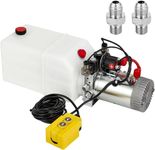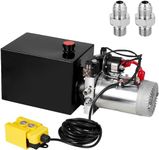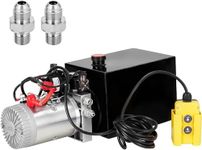Buying Guide for the Best Hydraulic Presses
Choosing the right hydraulic press can be a daunting task, but with the right knowledge, you can make an informed decision that best suits your needs. Hydraulic presses are used in various industries for tasks such as forming, molding, punching, and assembling. The key to selecting the right hydraulic press is understanding the specifications that matter most to your specific application. Here are some key specs to consider and how to navigate them.TonnageTonnage refers to the maximum amount of force the hydraulic press can exert. This is crucial because it determines the press's ability to handle different materials and tasks. Tonnage is typically measured in tons. For light-duty tasks, such as small part assembly or light stamping, a press with lower tonnage (up to 20 tons) may suffice. For medium-duty tasks, like forming or punching thicker materials, a press with medium tonnage (20-100 tons) is more appropriate. Heavy-duty tasks, such as deep drawing or heavy forging, require high tonnage presses (over 100 tons). Assess the materials and tasks you will be working with to determine the appropriate tonnage for your needs.
Stroke LengthStroke length is the distance the ram (the part of the press that moves up and down) travels during a single cycle. This spec is important because it affects the press's ability to handle different sizes and shapes of materials. Shorter stroke lengths (up to 6 inches) are suitable for tasks requiring precision and control, such as small part assembly. Medium stroke lengths (6-12 inches) are ideal for general forming and punching tasks. Longer stroke lengths (over 12 inches) are necessary for deep drawing and forming large or complex parts. Consider the size and shape of the materials you will be working with to choose the right stroke length.
Daylight OpeningDaylight opening is the maximum distance between the press bed and the ram when the ram is fully retracted. This spec is important because it determines the maximum height of the workpiece that can be placed in the press. Smaller daylight openings (up to 12 inches) are suitable for compact tasks and smaller workpieces. Medium daylight openings (12-24 inches) are ideal for general tasks and medium-sized workpieces. Larger daylight openings (over 24 inches) are necessary for large or tall workpieces. Evaluate the height of the materials you will be working with to select the appropriate daylight opening.
Bed SizeBed size refers to the dimensions of the press bed, which is the surface on which the workpiece rests. This spec is important because it affects the size of the workpiece that can be accommodated. Smaller bed sizes (up to 12x12 inches) are suitable for small parts and precision tasks. Medium bed sizes (12x24 inches) are ideal for general tasks and medium-sized workpieces. Larger bed sizes (over 24x24 inches) are necessary for large or complex workpieces. Consider the dimensions of the materials you will be working with to choose the right bed size.
SpeedSpeed refers to the rate at which the ram moves during operation. This spec is important because it affects the efficiency and productivity of the press. Slower speeds (up to 1 inch per second) are suitable for tasks requiring precision and control, such as small part assembly. Medium speeds (1-3 inches per second) are ideal for general forming and punching tasks. Faster speeds (over 3 inches per second) are necessary for high-volume production and tasks requiring quick cycle times. Consider the nature of your tasks and the desired production rate to select the appropriate speed.
Control SystemThe control system refers to the mechanism used to operate and regulate the hydraulic press. This spec is important because it affects the ease of use and precision of the press. Manual control systems are suitable for simple tasks and small-scale operations. Semi-automatic control systems offer a balance between manual and automatic operation, making them ideal for medium-scale tasks. Fully automatic control systems provide the highest level of precision and efficiency, making them suitable for large-scale production and complex tasks. Consider the complexity of your tasks and the level of control required to choose the right control system.





















